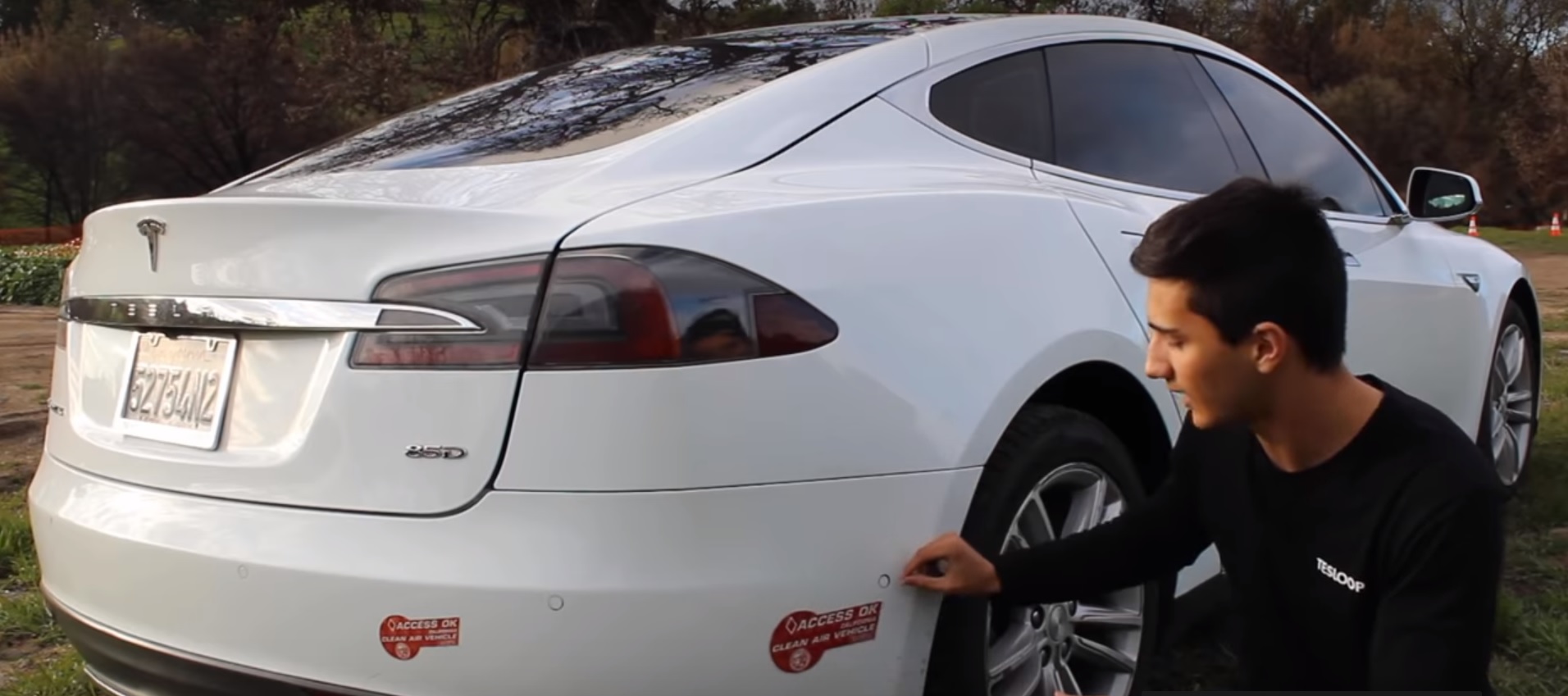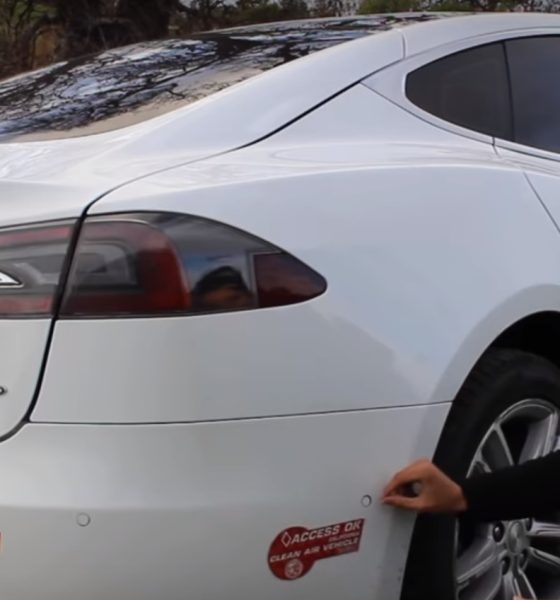

Lifestyle
Tales from a Tesla Model S with 450,000 miles: Battery life, durability, and more
The quality and durability of Tesla’s vehicles are not just talking points for fans of the all-electric car manufacturer – they’re traits that prove themselves time and again as a benefit of the ownership experience. In a recent example, a 2015 Tesla Model S that’s driven almost 450,000 miles shuttling passengers over long distances was shown to be still running strong and ready for more travel, according to a video overview posted by the founder of the company that owns it, Tesloop.
Tesloop is a connected mobility company for Tesla owners that’s currently developing an open-source mobile app called Carmiq. The company previously operated as a Tesla-only ride share service, offering trips between various cities in southern California and Las Vegas. The long distances involved in Tesloop’s operations put its Tesla fleet to incredible endurance tests, and aside from wear-and-tear seen in most vehicles with similar milage or less, the company’s experience with its 2015 Model S was very positive overall and it still drives well today.
“I think this is the only car that I can confidently say drives better today than it did three years ago and after 450,000 miles. And that’s due to the over-the-air software which has updated the car with Autopilot…The general driving feel of it is still really good…I think it would be very hard to tell this car has this many miles on it if you didn’t know,” Haynd Sonnad, founder of Tesloop, commented in the video.
Nicknamed “eHawk”, Tesloop’s Model S was built in June 2015 and has required a few repairs and major services during its lifetime. Some were paid for by Tesloop as part of its day-to-day business needs, such as tire replacement, and several others were paid for by Tesla under the car’s warranty, such as high voltage battery replacement.

A spreadsheet documenting all of the Model S’s service and maintenance experiences was published alongside its video overview for specific details. As listed, the most notable major events over the vehicle’s life time were the front drive unit replacement at 36,404 miles due to a part failure and two main battery replacements, one at 194,237 miles, the other at 324,044 miles. All three replacements were covered under the car’s 8-year, unlimited-mile warranty.
The first battery pack the Tesla Model S had experienced 1.2 miles of range lost per 10,000 miles while being driven about 17,000 miles per month and was replaced due to a battery chemistry issue. The second pack was losing about 4.7 miles every 10,000 miles driven, and its replacement was due to a defect in the battery assembly. The current battery is a 90 kWh pack and showing a loss of about 2.4 miles of range per 10,000 miles driven; however, about midway through the mileage, the car was transitioned from a long distance shuttle to a daily rental car, so the averages may not be a great reflection on its efficiency. At about 126,000 miles into the new pack, eHawk’s battery degradation is around 9%.
Also worth a mention are the brake pad and rotor replacements made for all the Model S’s wheels at 225,351 miles despite the average tire replacement taking place about every 53,000 miles from the long distances driven during regular use. The total owner cost for repairs after nearly 450,000 miles was listed as under $13,000, and general vehicle repairs came in at under $15,000.
During Tesla’s Autonomy Day investor event, CEO Elon Musk estimated that a new battery pack set to go into production next year would operate for one million miles with minimal maintenance, and the improvements are being driven by the company’s march towards its autonomous Tesla Network robo taxi service. Tesloop’s early adoption of Tesla’s vehicles may have meant the company’s most advanced technology wasn’t immediately available to take advantage of, but considering the results seen at 450,000 miles with an older variation, the quality and durability of Tesla vehicles have already proven themselves worth ownership at any stage of development.
To see Tesloop’s full overview of its 450,000-mile, 2015 Tesla Model S’s condition, watch the video below.
https://www.youtube.com/watch?v=rhbD44jXffY

Lifestyle
Tesla Model S Plaid battles China’s 1500 hp monster Nurburgring monster, with surprising results
There is just something about Tesla’s tuning and refinement that makes raw specs seem not as game-changing.

The Tesla Model S Plaid has been around for some time. Today, it is no longer the world’s quickest four-door electric sedan, nor is it the most powerful. As per a recent video from motoring YouTube channel Carwow, however, it seems like the Model S Plaid is still more than a match for some of its newer and more powerful rivals.
The monster from China
The Xiaomi SU7 Ultra is nothing short of a monster. Just like the Model S Plaid, it features three motors. It also has 1,548 hp and 1,770 Nm of torque. It’s All Wheel Drive and weighs a hefty 2,360 kg. The vehicle, which costs just about the equivalent of £55,000, has been recorded setting an insane 7:04.957 at the Nurburgring, surpassing the previous record held by the Porsche Taycan Turbo GT.
For all intents and purposes, the Model S Plaid looked outgunned in Carwow’s test. The Model S Plaid is no slouch with its three motors that produce 1,020 hp and 1,420 Nm of torque. It’s also a bit lighter at 2,190 kg despite its larger size. However, as the Carwow host pointed out, the Model S Plaid holds a 7:25.231 record in the Nurburgring. Compared to the Xiaomi SU7 Ultra’s record, the Model S Plaid’s lap time is notably slower.
Real-world tests
As could be seen in Carwow’s drag races, however, Tesla’s tech wizardry with the Model S Plaid is still hard to beat. The two vehicles competed in nine races, and the older Model S Plaid actually beat its newer, more powerful counterpart from China several times. At one point in the race, the Xiaomi SU7 Ultra hit its power limit due to its battery’s temperature, but the Model S Plaid was still going strong.
The Model S Plaid was first teased five years ago, in September 2020 during Tesla’s Battery Day. Since then, cars like the Lucid Air Sapphire and the Xiaomi SU7 Ultra have been released, surpassing its specs. But just like the Model Y ended up being the better all-rounder compared to the BYD Sealion 7 and the MG IM6, there is just something about Tesla’s tuning and refinement that makes raw specs seem not as game-changing.
Check out Carwow’s Model S Plaid vs Xiaomi SU7 drag race video below.
Lifestyle
500-mile test proves why Tesla Model Y still humiliates rivals in Europe
On paper, the BYD Sealion 7 and MG IM6 promised standout capabilities against the Model Y.

BYD is seeing a lot of momentum in Europe, so much so that mainstream media has taken every opportunity to argue that the Chinese automaker has beaten Tesla in the region. But while BYD sales this year in Europe are rising and Tesla’s registrations remain challenged, the raw capabilities of vehicles like the Model Y are difficult to deny.
This was highlighted in a 500-mile challenge by What Car? magazine, which showed that the new Tesla Model Y is more efficient, cheaper to run, and more reliable than rivals like the BYD Sealion 7, and even the nearly 400 KW-charging MG IM6.
Range and charging promises
On paper, the BYD Sealion 7 and MG IM6 promised standout capabilities against the Model Y. The Sealion 7 had more estimated range and the IM6 promised significantly faster charging. When faced with real-world conditions, however, it was still the Model Y that proved superior.
During the 500-mile test, the BYD nearly failed to reach a charging stop, arriving with less range than its display projected, as noted in a CarUp report. MG fared better, but its charging speeds never reached its promised nearly-400 kW charging speed. Tesla’s Model Y, by comparison, managed energy calculations precisely and arrived at each stop without issue.
Tesla leads in areas that matter
Charging times from 25% to 80% showed that the MG was the fastest at 17 minutes, while Tesla and BYD were close at 28 and 29 minutes, respectively. Overall efficiency and cost told a different story, however. The Model Y consumed 19.4 kWh per 100 km, compared to 22.2 for MG and 23.9 for BYD. Over the full trip, Tesla’s charging costs totaled just £82 thanks to its supercharger network, far below BYD’s £130 and MG’s £119.
What Car? Magazine’s testers concluded that despite BYD’s rapid sales growth and the MG IM6’s seriously impressive charging speeds, Tesla remains the more compelling real-world choice. The Model Y just offers stability, efficiency, and a proven charging infrastructure through its Supercharging network. And as per the magazine’s hosts, the Model Y is even the cheapest car to own among the three that were tested.
Watch What Car? Magazine’s 500-mile test in the video below.
Lifestyle
Tesla Cybertruck slapped with world’s least intimidating ticket, and it’s pure cringe
One cannot help but cringe and feel second-hand embarrassment at the idea of a person just driving around with a stack of these babies.

A Cybertruck parked at Stanford Shopping Center in California was recently hit with what might be the most try-hard piece of paper ever slipped under a wiper blade: a “fake citation” accusing the driver of supporting a “fascist car.”
The note, shared on X by Tesla staff program manager Ryan Torres, quickly made the rounds on X, where it quickly gained attention as an example of how not to protest.
The world’s least intimidating ticket
According to the citation, the supposed “violation” was “driving a fascist car.” The remedial action? Take the bus, call an Uber, or ride a bike. The note also dubbed Elon Musk a “chainsaw-wielding Nazi billionaire.” Now, protests against Tesla and Elon Musk have become commonplace this year, but one cannot help but cringe and feel second-hand embarrassment at the idea of a person just driving around with a stack of fake anti-Tesla/Musk citations.
Torres pointed out the irony himself in his post on X. Tesla currently employs over 140,000 Americans, and SpaceX has put the U.S. firmly back at the top of space technology. As Torres put it, maybe the person behind the world’s least intimidating ticket should “read a book on innovation before vandalizing” other people’s property.
Peak performative clownery
Not to mention that the fake ticket’s logic collapses under its own weight. EVs like the Cybertruck are literally designed to reduce emissions, not “destroy the economy.” If anything, Tesla has bolstered the United States’ economy by fueling jobs in engineering, manufacturing, and clean energy. It’s not the first time a Tesla has been the target of vandalism or politically charged notes, but this one stands out for sheer cringe value.
Torres summed it up neatly: “Peak clownery.” On that point, at least, the citation earns full marks. In a way, though, perhaps cringe fake tickets are not as bad as the literal firebombs that were being thrown at Tesla stores and cars earlier this year because some critics were gleefully misinformed about Elon Musk.









